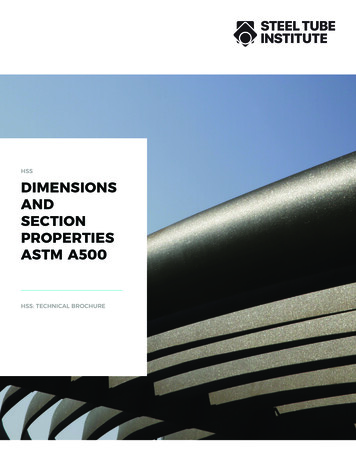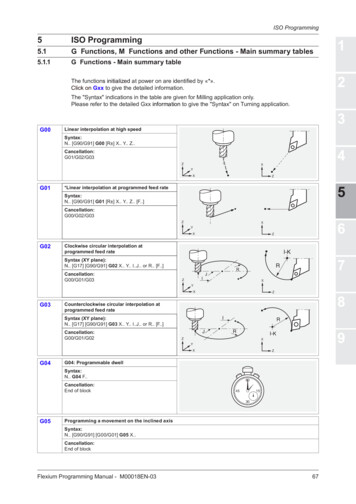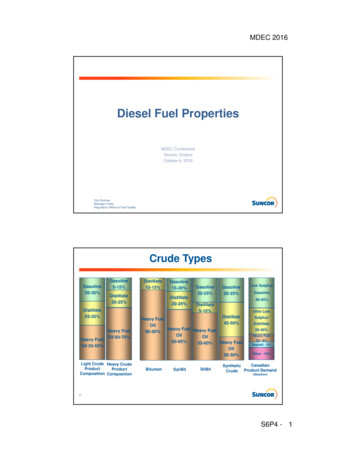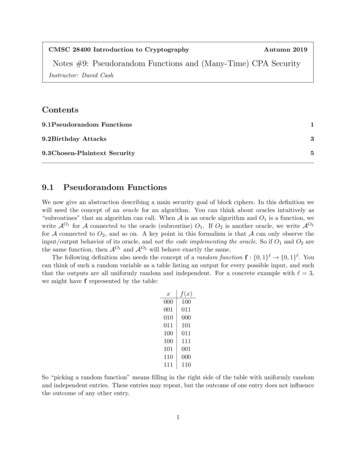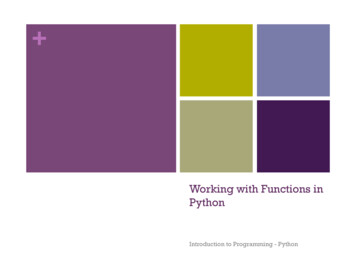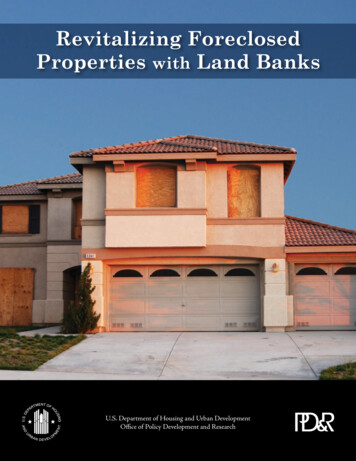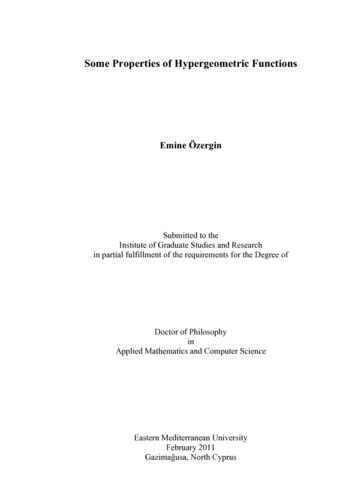
Transcription
Some Properties of Hypergeometric FunctionsEmine ÖzerginSubmitted to theInstitute of Graduate Studies and Researchin partial fulfillment of the requirements for the Degree ofDoctor of PhilosophyinApplied Mathematics and Computer ScienceEastern Mediterranean UniversityFebruary 2011Gazimağusa, North Cyprus
Approval of the Institute of Graduate Studies and ResearchProf. Dr. Elvan YılmazDirector (a)I certify that this thesis satisfies the requirements as a thesis for the degree of Doctorof Philosophy in Applied Mathematics and Computer Science.Prof. Dr. Agamirza BashirovChair, Department of MathematicsWe certify that we have read this thesis and that in our opinion it is fully adequate inscope and quality as a thesis for the degree of Doctor of Philosophy in AppliedMathematics and Computer Science.Assoc. Prof. Dr. Mehmet Ali ÖzarslanSupervisorExamining Committee1. Prof. Dr. Abdullah Altın2. Prof. Dr. Agamirza Bashirov3. Prof. Dr. Nazım Mahmudov4. Assoc. Prof. Dr. Mehmet Ali Özarslan5. Assoc. Prof. Dr. Svitlana Rogovchenko
ABSTRACTThis thesis consists of five chapters. The first chapter gives brief information about thethesis. In the second chapter, we give some preliminaries and auxilary results whichwe will use in thesis.In chapter three, the extension of beta function containing an extra parameter, whichproved to be useful earlier, was used to extend Appell’s hypergeometric functions oftwo variables and extend Lauricella’s hypergeometric function of three variables. Furthermore, linear and bilinear generating relations for these extended hypergeometricfunctions are obtained by defining the extension of fractional derivative operator. Someproperties of the extended fractional derivative operator are also presented.In chapter four, we consider generalizations of gamma, beta and hypergeometric functions. Some recurrence relations, transformation formulas, operation formulas andintegral representations are obtained for these new generalizations.In chapter five, we present various families of generating functions for a class of polynomials in two variables. Furthermore, several general classes of bilinear, bilateral ormixed multilateral generating functions are obtained for these polynomials.Keywords: Generating functions, Hypergeometric function, Fractional derivative operator, Gamma function, Beta function.iii
ÖZBu tez beş bölümden oluşmuştur. Birinci bölümde tezin içeriği ile ilgili genel bilgilerverilmiştir. İkinci bölümde, tez boyunca kullanılacak olan temel bilgiler ve sonuçlarverilmiştir.Üçüncü bölümde, daha önceden kullanışlı olduğu ıspatlanmış olan ve ekstra bir parametre içeren genişletilmiş beta fonksiyonu kullanılarak, iki değişkenli genişletilmişAppell hipergeometrik fonksiyonları ve üç değişkenli genişletilmiş Lauricella hipergeometrik fonksiyonları verilmiştir. Yine bu bölümde, yeni bir kesirli türev operatörütanımlanarak, genişletilmiş hipergeometrik fonksiyonlar için lineer ve bilineer doğurucu fonksiyon bağıntıları elde edilmiştir. Genişletilmiş kesirli türev operatörünün bazıözellikleri de sunulmuştur.Dördüncü bölümde, genişletilmiş gamma, beta ve hipergeometrik fonksiyonlar elealınmıştır. Bu yeni genelleşmeler için, bazı rekürans bağıntıları, dönüşüm formüllerive integral gösterimler elde edilmiştir.Beşinci bölümde, iki değişkenli polinom sınıfı için bir çok doğurucu fonksiyon ailelerisunulmuştur. Yine bu bölümde, bu polinomlar için daha geniş bilineer, bilateral vekarışık multilateral doğurucu fonksiyon sınıfları elde edilmiştir.Anahtar Kelimeler: Doğurucu fonksiyon, Hipergeometrik fonksiyon, Kesirli türevoperatörü, Gamma fonksiyonu, Beta fonksiyonu.iv
ACKNOWLEDGEMENTSFirst of all, I mostly would like to thank to my supervisor Assoc. Prof. Dr. MehmetAli Özarslan for his unwavering guidance, supervision, suggestions, support and encouragement during the Phd process and the preperation of this thesis.Also, I am thankful to Asst. Prof. Dr. Mustafa Rıza sharing his precious time and hishelp on editing my thesis.Finally, I express my thanks to my parents, my husband on unwavering moral andemotional support and my daughter Eylül for her patience, understanding and love.This thesis was supported, inpart, by the Ministry of National Education of TRNCunder Project MEKB-09-01.v
TABLE OF CONTENTSABSTRACT.iiiÖZ .ivACKNOWLEDGEMENTS . vLIST OF SYMBOLS .viii1 INTRODUCTION . 12 PRELIMINARIES AND AUXILIARY RESULTS . 62.1 Gamma, Beta Functions and their extended versions . 62.2 Hypergeometric Functions and their extended versions . 82.3 Some Hypergeometric Functions of two and more variables . 112.4 Generating Functions . 122.5 Mellin Transform and Riemann-Liouville Fractional Derivative. 142.6 Elementary Series Identity . 162.7 Some Important Polynomials. 173 SOME GENERATING RELATIONS FOR EXTENDED HYPERGEOMETRICFUNCTIONS VIA GENERALIZED FRACTIONAL DERIVATIVE OPERATOR. 183.1 Introduction. 183.2 The Extended Appell’s Functions . 193.3 Extended Riemann-Liouville Fractional Derivative . 223.4 Mellin Transforms and Extended Riemann-Liouville Fractional DerivativeOperator . 273.5 Generating Functions . 29vi
4 EXTENSION OF GAMMA, BETA AND HYPERGEOMETRIC FUNCTIONS . 324.1 Introduction. 324.2 Some Properties of Gamma and Beta Functions . 334.3 Generalized Gauss Hypergeometric and Confluent Hypergeometric Functions. 394.4 Integral Representations of the GGHF and GCHF . 404.5 Differentiation Formulas for the New GGHF's and New GCHF's . 414.6 Mellin Transform Representation of the GGHF's and GCHF's. 424.7 Transformation Formulas. 434.8 Differential Recurrence Relations for GGHF's and GCHF's . 455 SOME FAMILIES OF GENERATING FUNCTIONS FOR A CLASS OFBIVARIATE POLYNOMIALS . 465.1 Introduction. 465.2 First Set of Main Results and Their Consequence . 475.3 Multilinear and Multilateral Generating Functions . 53REFERENCES . 57vii
LIST OF SYMBOLSΓ(z)Gamma functionB(x, y)Beta function2 F1 (a, b; c; z)Gauss hypergeometric functionφ(a; c; z)Confluent hypergeometric functionp Fq (a1 , ., ap ; b1 , ., bq ; z)Generalized hypergeometric functionF1 (a, b, c; d; x, y)First Appell’s hypergeometric functions in two variablesF2 (a, b, c; d, e; x, y)Second Appell’s hypergeometric functions in two variablesFD3 (a, b, c, d; e; x, y, z)Lauricella’s hypergeometric functions in three variables(α,β)Γp(z)generalization of gamma function(α,β)(x, y)generalization of beta function(α,β)(a, b; c; z)generalized Gauss hypergeometric function(a; c; z)generalized confluent hypergeometric functionBpFp(α,β)φpF1 (a, b, c; d; x, y; p)extended First Appell’s hypergeometric functionsin two variablesF2 (a, b, c; d, e; x, y; p)extended Second Appell’s hypergeometric functionsin two variables3FD,p(a, b, c, d; e; x, y, z)extended Lauricella’s hypergeometric functionsin three variables(α,β)gn(x, y)(α,β)hn(x, y)Hn (x, y)(α,β)Pn(z)Lagrange polynomials in two variablesLagrange-Hermite polynomials of two variablesHermite-Kampé de Feriét polynomials of two variablesJacobi polynomialsDzµRiemann-Liouville fractional derivative of order µDzµ,pextended Riemann-Liouville fractional derivativeof order µM {f : s}Mellin transform of fviii
Chapter 1INTRODUCTIONMany important functions in applied sciences are defined via improper integrals or series (or infinite products). The general name of these important functions are calledspecial functions. The most famous among them is the gamma function. The gammafunction was first introduced by the Swiss mathematician Leonhard Euler (1707-1783)in his goal to generalize the factorial function to non-integer numbers (real and complex numbers). Later, gamma function was studied by other famous mathematicianslike Adrien-Marie Legendre (1752-1833), Carl Friedrich Gauss (1777-1855), ChristophGudermann (1798-1852), Joseph Liouville (1809-1882), Karl Weierstrass (1815-1897),Charles Hermite (1822-1901).For a complex number z with positive real part (Re (z) 0), the Gamma function isdefined byZ Γ(z) : tz 1 exp ( t) dt.0In studying the gamma function, Euler discovered another function, called the betafunction,B (x, y) Γ (x) Γ (y)Γ (x y)(Re(x) 0, Re(y) 0)which is closely related to Γ (z).Gauss investigated hypergeometric series, which had in fact already been defined and1
named by Wallis in the 1650s. He noted that the 2 F1 or Gauss hypergeometric functionactually covered a lot of known special functions. The Gauss hypergeometric function(GHF) is defined by2 F1 (a, b; c; z): X(a)n (b)n z n(c)nn 0n!,( z 1; Re(c) Re(b) 0, c 6 0, 1, 2, .).The Confluent hypergeometric function (CHF) φ(a; c; z) is also known as the Kummerfunction which is defined byφ(a; c; z) X(a)n z nn 0(c)n n!,(Re(c) Re(a) 0).In recent years, several extensions of the well known special functions (gamma, betaetc.) have been considered by several authors [8], [4], [7], [6], [21], [22]. In [8] and [4],M.A. Chaudhry et al. defined extension of gamma function and Euler’s beta functionsbyZ Γp (x) : tx 1 exp t pt 1 dt,0(Re (x) 0, Re (p) 0)andZ1tBp (x, y) : x 1y 1(1 t)0 pexp dt,t(1 t)(Re(p) 0, Re(x) 0, Re(y) 0)respectively. For which p 0 gives the original gamma and beta functions. Thenthey have been proved that this extension has connection with Macdonald, error andWhittaker’s functions. Afterwards, in [5], M.A. Chaudhry et al. generalized the Gausshypergeometric and confluent hypergeometric functions by XBp (b n, c b)znFp (a, b; c; z) (a)nB (b, c b)n!n 0(p 0 ; Re (c) Re (b) 0)2
andφp (b; c; z) XBp (b n, c b) z nB (b, c b)n 0n!(p 0 ; Re (c) Re (b) 0)respectively. For which p 0 gives the original Gauss hypergeometric and confluent hypergeometric functions. They gave the Euler type integral representations ofthe hypergeometric functions. Additionally, they have discussed the differentiationproperties and Mellin transforms of Fp (a, b; c; z) (φp (b; c; z)) and obtained transformation formulas, recurrence relations, summation and asymptotic formulas for thesefunctions.We organize the thesis as follows:In chapter 2, we give some preliminaries and auxilary results which are used throughout the thesis.Chapter 3, 4 and 5 are the original parts of the thesis. It should be noted that the resultsobtained in these Chapter’s were published in [27], [25] and [26] respectively.In chapter 3, we obtain some linear and bilinear generating functions by means of thenew defined extended Appell’s functions F1 (a, b, c; d; x, y; p), F2 (a, b, c; d, e; x, y; p),3(a, b, c, d; e; x, y, z) which areand extended Lauricella’s hypergeometric function FD,pdefined by Xxn y mBp (a m n, d a)(b)n (c)mF1 (a, b, c; d; x, y; p) : B(a, d a)n! m!n,m 0(max { x , y } 1), X(a)m n Bp (b n, d b) Bp (c m, e c) xn y mF2 (a, b, c; d, e; x, y; p) : B (b, d b) B (c; e c)n! m!n,m 0( x y 1),3
and3(a, b, c, d; e; x, y, z) : FD,p XBp (a m n r, e a) (b)m (c)n (d)r xm y n z rB (a, e a)m! n! r!m,n,r 0ppp( x y z 1),respectively. Notice that the case p 0 gives the original functions. In obtaining thesegenerating functions we consider a new fractional derivative operator [25], namely: Z z1 pz 2 µ 1µ,pDz {f (z)} f (t) (z t)expdt,Γ ( µ) 0t(z t)(Re (µ) 0, Re (p) 0)for which p 0 gives original fractional derivative operator.In chapter 4, we present generalizations of gamma and beta functions [26] byZ p (α,β)x 1Γp (x) : tdt1 F1 α; β; t t0(Re(α) 0, Re(β) 0, Re(p) 0, Re(x) 0)andBp(α,β)Z(x, y) : 1x 1(1 t)ty 1 1 F1 α; β;0 pt(1 t) dt,(Re(p) 0, Re(x) 0, Re(y) 0, Re(α) 0, Re(β) 0)respectively. Then we use the new generalization of beta function to generalize thehypergeometric and confluent hypergeometric functions byFp(α,β)(a, b; c; z) : X(α,β)(a)nn 0Bp(b n, c b) z nB (b, c b)n!(Re(p) 0, Re(c) 0, Re(b) 0, Re(α) 0, Re(β) 0)andφ(α,β)p(b; c; z) : (α,β)XBp(b n, c b) z nB (b, c b)n 0n!,(Re(p) 0, Re(c) 0, Re(b) 0, Re(α) 0, Re(β) 0)4
respectively. The case α β gives Chaudry’s gamma, beta and hypergeometric functions. Then, we obtain some recurrence relations, transformation formulas, operationformulas and integral representations for these new generalizations.In chapter 5, we consider the following family of bivariate polynomials,Snm,N (x, y) : [ Nn ]XAm n,kk 0(n, m N0 ;xn N k y k(n N k)! k!N N),which was defined by Altın et al. [1]. We prove several general theorems involvingvarious families of generating functions for the aforementioned polynomials in theirtwo-variable notation Snm,N (x, y) by applying the method which was used recently byChen and Srivastava [12]. We also consider some applications and corollaries resultingfrom these theorems [27].5
Chapter 2PRELIMINARIES AND AUXILIARY RESULTS2.1Gamma, Beta Functions and their extended versionsIn this section, we give definitions of the gamma and beta functions and their properties. Furthermore, we give extended forms of these special functions ( see [2], [28]).Definition 2.1.1. (Euler Gamma function) For a complex number z with positive realpart (Re (z) 0), the gamma function is defined byZ Γ(z) : tz 1 exp ( t) dt.(2.1)0Using integration by parts, one can show that the following recurrance relation holdfor Γ(z):Γ(z 1) zΓ(z).This functional equation generalizes the definition n! n(n 1)! of the factorialfunction. But also, evaluating Γ (1) analytically we getΓ (1) 1.Combining these two results we see that the factorial function is a special case of thegamma function:Γ(n 1) nΓ(n) n (n 1) Γ(n 1) . n!Γ(1) n!.Another useful function is a beta function.6
Definition 2.1.2. The beta function, (also called the Eulerian integral of the first kind)is defined byZ1tx 1 (1 t)y 1 dt.B (x, y) : 0(Re (x) 0, Re (y) 0)Equivalently,Zπ2B (x, y) : 2(sin θ)2x 1 (cos θ)2y 1 dθ,0(Re (x) 0, Re (y) 0)andZ ux 1du.(1 u)x yB (x, y) : 0(Re (x) 0, Re (y) 0)The beta function is symmetric, B (x, y) B (y, x) and it is related to the gammafunction;B (x, y) Γ(x)Γ(y).Γ(x y)(2.2)(x, y 6 0, 1, 2, .)In 1994, Chaudhry and Zubair [8] introduced the following extension of gamma function.Definition 2.1.3. (see [8], [10])The Extended Gamma function is defined byZ Γp (x) : tx 1 exp t pt 1 dt,(2.3)0(Re (x) 0, Re (p) 0).In 1997, Chaudhry et al. [4] presented the following extension of Euler’s beta function.7
Definition 2.1.4. (see [4]) The Extended Beta function is defined by Z 1py 1x 1Bp (x, y) : t(1 t) exp dt,t(1 t)0(2.4)(Re(p) 0, Re(x) 0, Re(y) 0).It is clearly seem that Γ0 (x) Γ (x) and B0 (x, y) B (x, y).2.2Hypergeometric Functions and their extended versionsIn this section, we give definition and some properties of the hypergeometric functions.The second order linear differential equationdyd2 yz(1 z) 2 [c (a b 1)z] aby 0,dzdzin which a, b and c are real or complex parameters, is called the hypergeometric equation. Series solutions of the hypergeometric equation valid in the neighborhoods ofz 0, 1 or can be developed by using Frobenious series method. Thus, if c is notan integer, the general solution of differential equation valid in a neighborhood of theorigin is found to bey A 2 F1 (a, b; c; z) Bz 1 c 2 F1 (a c 1, b c 1; 2 c; z),where A and B are arbitrary constants, and2 F1 (a, b; c; z) 1 aba(a 1)b(b 1) 2z z .c.1c(c 1).1.2 X(a)n (b)n z nn 0(c)nn!,(c 6 0, 1, 2, .)where (λ)ν denotes the Pochhammer symbol defined by(λ)0 1 and (λ)ν : Γ(λ ν).Γ(λ)Hence2 F1 (a, b; c; z) X(a)n (b)n z nn 08(c)nn!,
is called Gauss hypergeometric function. This series is convergent for z 1 whereRe(c) Re(b) 0 and z 1 where Re(c a b) 0.The Gauss hypergeometric function can be given by Euler’s integral representation asfollows:Γ (c)2 F1 (a, b; c; z) Γ(b)Γ(c b)1Ztb 1 (1 t)c b 1 (1 zt) a dt,0( z 1; Re(c) Re(b) 0).Replacing z zand by letting b , in Gauss’s hypergeometric equation, webhavezd2 ydy (c z) ay 0.dz 2dzThis equation has a regular singularity at z 0. The simplest solution of the equationisaa(a 1) 2z z .c.1c(c 1).1.2φ(a; c; z) 1 X(a)n z nn 0(c)n n!,(c 6 0, 1, 2, .).Hence, we getφ(a; c; z) X(a)n z nn 0(c)n n!,which is called confluent hypergeometric function.The confluent hypergeometric function can be given by an integral representation asfollows:Γ (c)φ(a; c; z) Γ(a)Γ(c a)Z1ta 1 (1 t)c a 1 exp (zt) dt,0(Re(c) Re(a) 0).9
A generalized form of the hypergeometric function is X(α1 )n .(αp )n z np Fq (α1 , .αp ; γ1 , ., γq ; z) n 0(γ1 )n .(γq )n n!,(2.5)(p, q 0, 1, .).Setting p 2, q 1 in (2.5), we get the Gauss hypergeometric function,F (α1 , α2 ; γ1 ; z) : 2 F1 (α1 , α2 ; γ1 ; z) X(α1 )n (α2 )n z n(γ1 )nn 0n!.Setting p q 1 in (2.5), we get confluent hypergeometric function,φ(α1 ; γ1 ; z) 1 F1 (α1 ; γ1 ; z) X(α1 )n z nn 0(γ1 )n n!.For the convergence of the series p Fq (see [28], [29]);case 1: If p q, then the series converges for all z;case 2: If p q 1, then the series converges for z 1 and otherwise series diverges;case 3: If p q 1, the series diverges for z 6 0.If the series terminates, there is no question of convergence, and the conclusions (case2) and (case 3) do not apply. If p q 1, then the series is absolutely convergent onthe circle z 1 ifReqXγj j 1pX!αi 0.i 1In 2004, Chaudhry et al. [5] used extended beta function Bp (x, y) to extend the hypergeometric functions (and confluent hypergeometric functions) as follows:Fp (a, b; c; z) XBp (b n, c b)n 0B (b, c b)(a)n(p 0 ; Re (c) Re (b) 0),10znn!
φp (b; c; z) XBp (b n, c b) z nn 0B (b, c b)n!(p 0 ; Re (c) Re (b) 0),and gave the Euler type integral representations1Fp (a, b; c; z) B (b, c b)1Zb 1t(1 t)c b 1 a(1 zt) exp 0 pdtt(1 t)(2.6)(p 0 ; p 0 and arg (1 z) π p; Re (c) Re (b) 0),andexp(z)φp (b; c; z) B (b, c b)1Zc b 1t(1 t)0b 1 pdtexp zt t(1 t) (2.7)(p 0 ; p 0 and Re (c) Re (b) 0).They called these functions as extended Gauss hypergeometric function (EGHF) andextended confluent hypergeometric function (ECHF), respectively, since F0 (a, b; c; z) 2 F1(a, b; c; z) and φ0 (b; c; z) 1 F1(b; c; z). They have discussed the differentia-tion properties and Mellin transforms of Fp (a, b; c; z) and φp (b; c; z) . They obtainedtransformation formulas, recurrence relations, summation and asymptotic formulas forthese functions.2.3Some Hypergeometric Functions of two and more variablesThere are four Appell’s hypergeometric functions of two variables (see [13], [31]). Inthis thesis we consider the first two Appell’s hypergeometric functions. These functions are defined by XB(a m n, d a)xn y mF1 (a, b, c; d; x, y) : (b)n (c)mB(a, d a)n! m!n,m 0(max { x , y } 1),11
and X(a)m n B (b n, d b) B (c m, e c) xn y mF2 (a, b, c; d, e; x, y) : B (b, d b) B (c; e c)n! m!n,m 0( x y 1).Lauricella functions of three variables are defined byFD3 XB (a m n r, e a) (b)m (c)n (d)r xm y n z r(a, b, c, d; e; x, y, z) : B (a, e a)m! n! r!m,n,r 0ppp( x y z 1).The Appell’s hypergeometric functions F1 and F2 can be given an integral representation as follows:F1 (a, b, c; d; x, y) Z 1Γ (d)Γ (a) Γ (d a)ta 1 (1 t)d a 1 (1 xt) b (1 yt) c dt,0( arg (1 x) π, arg (1 y) π; Re (d) Re (a) 0).and1F2 (a, b, c; d, e; x, y; p) B (b, d b) B (c, e c)Z1Z001 b 1t(1 t)d b 1 sc 1 (1 s)e c 1(1 xt ys)a( x y 1);(Re (d) Re (b) 0, Re (e) Re (c) 0, Re (a) 0).2.4Generating FunctionsIn this section, we give definitions of linear, bilinear, bilateral, multivariable, multilinear, multilateral and multiple generating functions, from the book [32].Definition 2.4.1. (Linear generating functions) If two-variable function F (x, t) canbe expanded as a formal power series expansion in t asF (x, t) Xn 012fn (x) tn
where each member of the coefficient set {fn (x)} n 0 is independent of t, then theF (x, t) is said to have generated the set {fn (x)}. Therefore F (x, t) is called a lineargenerating function for the set {fn (x)} .Definition 2.4.2. (Bilinear generating functions) If three-variable function F (x, y, t)can be expanded as a formal power series expansion in t such thatF (x, y, t) Xγn fn (x) fn (y) tnn 0where the sequence {γn } is independent of x,y and t, then F (x, y, t) is called a bilineargenerating function for the set {fn (x)} .Definition 2.4.3. (Bilateral generating functions) If three-variable function H (x, y, t)which is defined by a formal power series expansion in t asH (x, y, t) Xhn fn (x) gn (y) tnn 0where the sequence {hn } is independent of x, y and t, and the sets of functions {fn (x)} n 0and {gn (x)} n 0 are different, then H (x, y, t) is called a bilateral generating functionfor the set {fn (x)} or {gn (x)} .Definition 2.4.4. (Multivariable generating functions) Suppose that G (x1 , ., xr ; t) isa function of r 1 variables, which is defined by a formal power series expansion in tsuch thatG (x1 , ., xr ; t) Xcn gn (x1 , ., xr ) tnn 0where the sequence {cn } is independent of the variables x1 , ., xr and t. Then G (x1 , ., xr ; t)is called a multivariable generating function for the set {gn (x1 , ., xr )} n 0 corresponding to the nonzero coefficients cn .Definition 2.4.5. (Multilinear and multilateral generating functions) A multivariablegenerating functions G (x1 , ., xr ; t) which is defined in previous definition, is said tobe a multilinear generating function ifgn (x1 , ., xr ) fα1 (n) (x1 ).fαr (n) (xr )13
where the sequence α1 (n), ., αr (n) are functions of n which are not necessarily equal. If the functions fα1 (n) (x1 ) , . fαr (n) (xr ) are all different, the multivariable generating function G (x1 , ., xr ; t) is called a multilateral generating function.Definition 2.4.6. (Multiple generating functions) An extension of the multivariablegenerating function is said to be a multiple generating function which is defined formally byΨ (x1 , ., xr ; t1 , ., tr ) XC(n1 , .nr ) n1 ,.,nr (x1 , ., xr ) tn1 1 .tnr rn1 ,.,nr 0where the multiple sequence {C(n1 , .nr )} is independent of the variables x1 , ., xrand t1 , .tr .2.5Mellin Transform and Riemann-Liouville Fractional DerivativeIn this section, we give the definition of the Mellin transform and fractional derivativeoperator.Definition 2.5.1. Let f (x) be a function defined on the positive real axis 0 x .The Mellin transformation M is the operation, mapping the function f into the functionF , defined on the complex plane by the relation:Z M {f : s} F (s) xs 1 f (x)dx.0The function F (s) is called the Mellin transform of f.Example 2.5.2. The Mellin transform of the function f (x) exp( px) (p 0) isM {f : s} p s Γ(s)(Re(s) 0).Indeed, in order to obtain the Mellin transform of f (x) exp( px), we multiply bothsides of function f (x) by ps 1 and integrate with respect to p over the interval [0, ).14
ThusZ xs 1 exp( px)dx.M {f : s} F (s) 0Using the definition of the Gamma function, we getM {f : s} p s Γ(s).Definition 2.5.3. (Mellin inversion formula) The inverse transform of the Mellin transform is given byM 11{F : x} f (x) 2πiZi x s F (s)ds. i Definition 2.5.4. [16] The Riemann-Liouville fractional derivative of order µ is defined byDzµ {fZ1(z)} Γ ( µ)zf (t) (z t) µ 1 dt,0(Re (µ) 0)where the integration path is a line from 0 to z in complex t plane. For the casem 1 Re (µ) m (m 1, 2, 3.) , it is defined bydm µ mD{f (z)}dz m z Z zdm1 µ m 1f (t) (z t)dt . mdzΓ ( µ m) 0Dzµ {f (z)} Example 2.5.5. Let Re (λ) 1, Re (µ) 0. ThenDzµ {z λ } Z z1tλ (z t) µ 1 dtΓ ( µ) 0Z 11(zu)λ (z) µ 1 (1 u) µ 1 duΓ ( µ) 0Z 1z λ µuλ (1 u) µ 1 duΓ ( µ) 0B (λ 1, µ) λ µΓ (λ 1)z z λ µ .Γ ( µ)Γ (λ µ 1)Example 2.5.6. Let Re (λ) 0, Re (µ) 0 and z 1. ThenDzλ µ {z λ 1 (1 z) α } Γ (λ) µ 1z2 F1 (α, λ; µ; z) .Γ (µ)15
Solution. Direct calculations yieldDzλ µ {z λ 1 α(1 z)1} Γ (µ λ)zZtλ 1 (1 t) α (z t)µ λ 1 dt0 µ λ 1zzt αλ 1 1 t(1 t)dtΓ (µ λ) 0zZz µ λ 1 z λ 1 λ 1 u(1 uz) α (1 u)µ λ 1 duΓ (µ λ) 0Γ (λ) µ 1z 2 F1 (α, λ; µ; z) .Γ (µ)µ λ 1ZHence the proof is completed.2.6Elementary Series IdentityIn this section, we give general series identities which are used throughout the thesis.Lemma 2.6.1. [28] The following series identities X X XnXA(k, n) n 0 k 0n 0 k 0 XnX X XA(k, n k)(2.8)C(k, n k)(2.9)andC(k, n) n 0 k 0n 0 k 0holds.Proof. Consider the series X XA(k, n)tn k(2.10)n 0 k 0in which tn k has been inserted for convenience and will be removed later by takingt 1. Introducing new indices of summation j and m byn m j,k j,(2.11)so that the exponent (n k) in (2.10) becomes m. Since n 0 and k 0 in (2.11)then j 0, m j 0 or m j 0. Thus we arrive at X Xn 0 k 0n kA(k, n)t XmXm 0 j 016A(j, m j)tm .(2.12)
Finally, putting t 1 in the equality (2.12) and replacing j and m by k and n, we get(2.8). Similarly, equation (2.9) follows from (2.8).Lemma 2.6.2. For a bounded sequence {f (N )} N 0 of essentially arbitrary complexnumbers, we have X XX(x y)Nxn y kf (N ) .f (n k)N!n! k!n 0 k 0N 0(2.13)Proof. Using the Lemma 2.6.1, we get X X XNXxn y kxN k y kf (n k)(n k)! N!f (N )n! k!(N k)! k!n 0 k 0N 0 k 0 n XXN N k k f (N )xykN 0k 0 Xf (N ) (x y)N .N 0Whence the result.2.7Some Important PolynomialsIn this section, we consider some important polynomials which will be used in Chapter5.Definition 2.7.1. Lagrange polynomials in two variables are defined bynXxn k y k(α,β)(α)n k (β)k.gn (x, y) (n k)!k!k 0Definition 2.7.2. Lagrange-Hermite polynomials of two variables are defined by[ n2 ]Xxn 2k y kh(α,β)(x,y) .(α)(β)n 2kkn(n 2k)!k!k 0Definition 2.7.3. Hermite-Kampé de Feriét polynomials of two variables are definedby[ n2 ]Xxn 2k y kHn (x, y) .(n 2k)!k!k 0Definition 2.7.4. [35] Jacobi polynomials are defined bynX( 1)n k (β 1)n (α β 1)n k kn!(α,β)z .Pn (z) (α β n 1)n k 0 k! (n k)! (β 1)k (α β 1)n17
Chapter 3SOME GENERATING RELATIONS FOREXTENDED HYPERGEOMETRIC FUNCTIONS VIAGENERALIZED FRACTIONAL DERIVATIVEOPERATOR3.1IntroductionRecently an extension of beta function containing an extra parameter, which proved tobe useful earlier, was used to extend the hypergeometric functions [5]. The aim of thischapter is to obtain some generating functions for extended hypergeometric functions(EHF) by considering a new fractional derivative operator. We organize this chapter asfollows.In the second section, extensions of the first two Appell’s hypergeometric functions oftwo variables, namely, F1 (a, b, c; d; x, y; p) and F2 (a, b, c; d, e; x, y; p), and extended3(a, b, c, d; e; x, y, z) , areLauricella’s hypergeometric function of three variables, FD,pdefined and integral representations of F1 (a, b, c; d; x, y; p) and F2 (a, b, c; d, e; x, y; p)are obtained. In the third section, extended fractional derivative operator is definedand extended fractional derivatives of some elementary functions, which are neededin obtaining generating functions, are calculated in terms of extended Appell’s hypergeometric functions and extended Lauricella’s hypergeometric function. In the fourthsection, some results related with Mellin transforms and extended fractional derivative operators are given. Last section contains the main results of the chapter. In thissection, linear and bilinear generating functions for the extended hypergeometric functions are obtained via generalized fractional derivative operator by following the same18
method explained in [32].3.2The E
TABLE OF CONTENTS ABSTRACT . Mff: sg Mellin transform of f viii. Chapter 1 INTRODUCTION Many important functions in applied sciences are defined via improper integrals or se-ries (or infinite products). The general name of these important functions are called special fun

